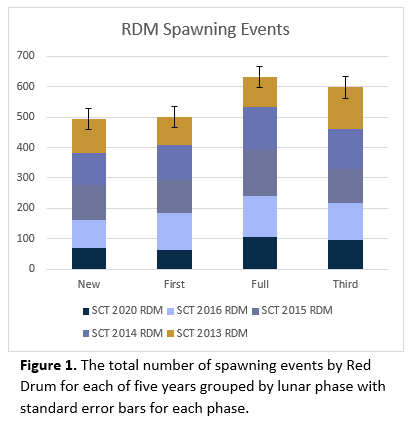LUNAR PERIODICITY IN REPRODUCTION OF RED DRUM IN AQUACULTURE
Lunar periodicity in spawning is documented in several marine species. Red Drum (Sciaenops ocellatus ) are in Sciaenidae, or the drum family. Red Drum use acoustics in their courtship and spawning behavior, and their acoustical spawning activities have been recorded in wild populations and linked to the lunar phase. Texas Parks and Wildlife has fish hatcheries for stock enhancement along the Texas coast of the Gulf of Mexico. Broodstock are housed in recirculating aquaculture systems indoors with controlled photoperiods and thermal cycles to induce volitional spawning. These broodstock tanks have no lunar phase illumination, yet lunar phase has a significant effect on the number of spawning events recorded by this species at the Sea Center Texas facility in Lake Jackson. An ANOVA test was run, producing a p-value of 0.0317.
Using the Fisher's Least Significant Difference test (alpha of 0.05) , it was found that R ed Drum spawning events are significantly more frequent during the full lunar phase when compared to the new and first phases.
This information can be used to maximize production. By working with the lunar cycle, thermal fluctuations can be used in conjunction with the lunar phase to increase spawning events on a schedule. Strategically preparing fertilized ponds to have zooplankton blooms when larvae are at first feeding stage can ensure that resources are successfully utilized.
